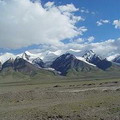 國際研究小組在冰冷、沒有樹木、多岩、海拔4500公尺高的西藏高原所進行的一項研究發現,在高原中的地層有一厚厚的湖底層沉積物,其中充滿了植物、魚類和動物化石,通常這樣的沉積物是典型較低海拔及濕暖氣候中才會出現。
國際研究小組在冰冷、沒有樹木、多岩、海拔4500公尺高的西藏高原所進行的一項研究發現,在高原中的地層有一厚厚的湖底層沉積物,其中充滿了植物、魚類和動物化石,通常這樣的沉積物是典型較低海拔及濕暖氣候中才會出現。
回到位於佛羅里達州立大學的美國國家高磁帶實驗室中分析之後,在這些化石裡面碳和氧的同位素顯示出這些動物是相當近期的生物,大約是200-300萬年前而已,而他們的食物來源是大量的植物。
科學家發現,這些動物是由於「一場劇烈的氣候變化」而在上新世末期滅絕,大約就是200-300萬年前。
地質學家早先表示,化石證據顯示出地殼運動使得西藏高原上升至目前的海拔高度,而且就在2百萬年前,而非數百萬年前,就使得原本在上面的植物和動物無法生存。
「西藏高原上升的年代和其所帶來的氣候生物變遷之所以是一個爭議性的話題,是因為人類還沒有機會接近到大部分西藏壯麗的山脈、峽谷和冰河,」佛羅里達州立大學地球科學助理教授王洋(Yang Wang)表示。
這項化石的研究發現在2008年6月15日出刊的論文期刊「Earth and Planetary Science Letters」中發表,王洋是這篇研究「庫倫走道盆地中哺乳類、魚類與貝殼類化石中的穩定同位素-西藏高原古氣候與古上升作用的應用」的作者之一,這篇論文還和洛杉磯自然歷史博物館的古生物學家和北京科學研究院的脊椎古生物學和古人類學研究所一起發表。
自2004以來的研究合作計畫以偏遠西藏高原的暑期原野研究為主,由美國國家科學基金會的沈澱地質學和古生物學計畫所贊助。
王洋表示,「到目前為止,我和我的研究伙伴只有在兩個盆地中蒐集資料,雖然只佔了西藏高原非常小一部份,但是我們至今的工作成果非常令人驚訝,因為此結果和西藏上升的主流觀點並不相同。」
她表示新的證據質疑了目前科學家所使用來重建過去該地區上升作用的研究方法的效度。
「確認此地區地殼構造和相關上升變動的歷史資料相當重要,因為西藏高原的上升是過去5到6千萬年全球氣候變遷的主因之一,」王洋表示。
「更重要的是,西藏高原也是當代亞洲季風形成的原因,亞洲季風控制了大部分亞洲,也是全球人口最密集地區的環境條件。」
2008年夏天,王洋和來自北京及洛杉磯的同事們將會回到西藏高原進行進一步的實地研究工作。
「我們工作的下一階段會聚焦在檢驗該區裡及附近長期植披和環境改變的空間和時間變化模式,這樣的紀錄對釐清氣候、生物和地殼的連鎖關係非常重要。」
Working 15,000 feet up on the cold, treeless, rocky desert of the Himalayan-Tibetan Plateau, an international research team was surprised to find thick layers of lake sediment filled with plant, fish and animal fossils typical of lower elevations and warmer, wetter climates.
Back at the U.S. National High Magnetic Field Laboratory at Florida State University, analysis of carbon and oxygen isotopes in the fossils has revealed that the animals lived recently in geologic terms - just two to three million years ago - and their diet was made up of abundant plants.
The scientists determined that "a drastic climate change" was the reason for their demise during the late Pliocene era, about two or three million years ago.
The scientific team says that fossil evidence suggests that movements of the Earth's crust caused the Tibetan Plateau to rise to its towering current elevations - making it inhospitable to the plants and animals that thrived there as recently as two million years ago, not millions of years earlier than that, as geologists previously believed.
"The uplift chronology of the Tibetan Plateau and its climatic and biotic consequences have been a matter of much debate and speculation because most of Tibet's spectacular mountains, gorges and glaciers remain barely touched by man and geologically unexplored," said Yang Wang, associate professor in the Florida State University Department of Geological Sciences.
The fossil findings are described in the June 15, 2008 issue of the peer-reviewed journal "Earth and Planetary Science Letters," online at: www.elsevier.com/locate/epsl. Yang co-authored the paper, "Stable isotopes in fossil mammals, fish and shells from Kunlun Pass Basin, Tibetan Plateau: Paleoclimatic and paleoelevation implications" with paleontologists from the Natural History Museum of Los Angeles County, and the Institute of Vertebrate Paleontology and Paleoanthropology, Chinese Academy of Sciences in Beijing.
The collaborative research project, which since 2004 has featured summer field study on the remote Tibetan Plateau, is funded by a grant from the Sedimentary Geology and Paleobiology Program of the U.S. National Science Foundation.
"So far, my research colleagues and I have only worked in two basins in Tibet, representing a very small fraction of the Plateau, but it is very exciting that our work to date has yielded surprising results that are inconsistent with the popular view of Tibetan uplift," said Yang.
She said the new evidence calls into question the validity of methods currently used by scientists to reconstruct the past elevations of the region.
"Establishing an accurate history of tectonic and associated elevation changes in the region is important because uplift of the Tibetan Plateau has been suggested as a major driving mechanism of global climate change over the past 50-60 million years," said Yang.
"What's more, the region also is thought to be important in driving the modern Asian monsoons, which control the environmental conditions over much of Asia, the most densely populated region on Earth."
This summer, Yang and her colleagues from Los Angeles and Beijing will return for more fieldwork in areas near the Tibetan Plateau.
"The next phase of our work will focus on examining the spatial and temporal patterns of long-term vegetative and environmental changes in and around the region," she said. "Such records are crucial for clarifying the linkages among climatic, biotic and tectonic changes."
全文及圖片詳見:ENS





